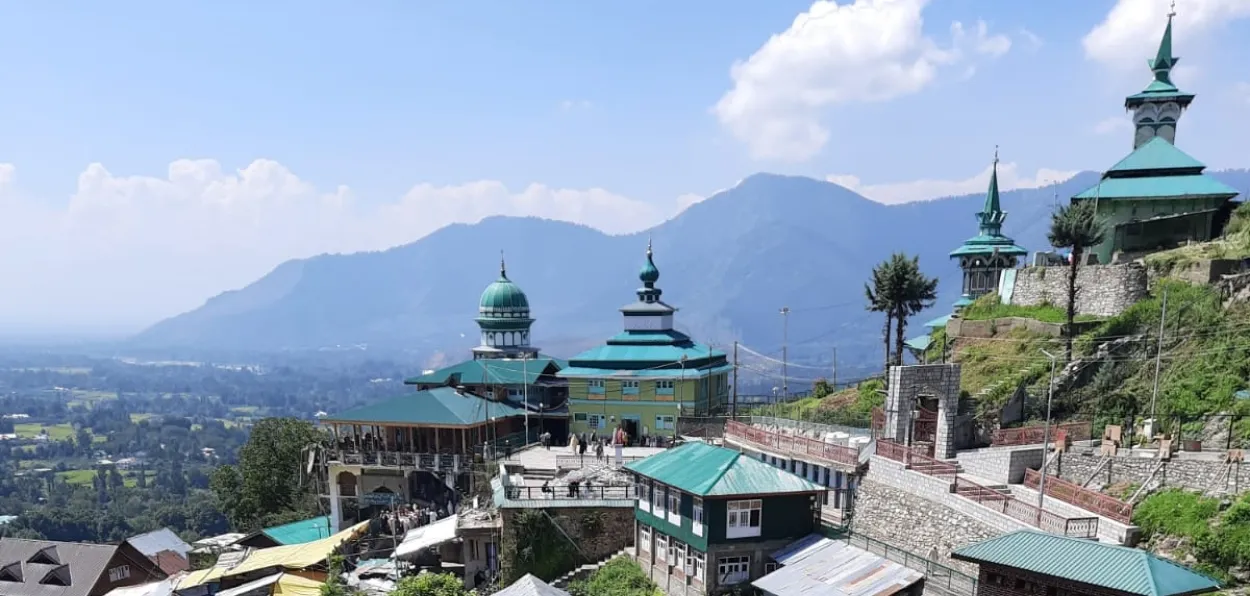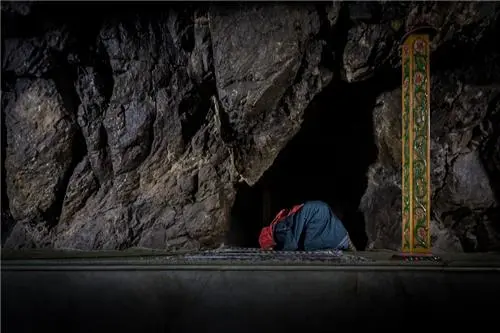
Ehsan Fazili/Srinagar
Mohammad Abdulla Bhat, a man close to his eighties, is waiting for public transport to take him to the shrine of Sheikh Zain-ud-Din Wali at Aishmuqam, Anantnag, in South Kashmir. He can see the grandiose shrine located uphill about 2 km from the Anantnag-Pahalgam road. Earlier one had to undertake a treacherous uphill trek and it was about a decade ago that a road was laid enabling senior citizens like Bhat to visit the shrine at will.
Bhat told me he has been coming from his village of Nanil on the outskirts of Anantnag, about 23 km away to seek the blessings of the Sufi saint for seven years.
Like Bhat, hundreds of devotees throng the shrine daily. The largest gathering is on Thursdays, a practice which is followed at several other Sufi shrines like that of Sheikh Nooruddin Noorani at Chrar-e-Sharief in Budgam.
Sheikh Nooruddin Noorani also known as Nund Rishi or Alamdar-e-Kashmir (Flag bearer of Kashmir) is the founder of the Sufi order in Kashmir more than 600 years ago and Sheikh Zain-ud-Din Wali is among his disciples.
The shrine is also famous for its Zool (lighting of Mashalls) festival which is held at the time of the sowing of paddy crops.
A man selling literature on Sufism at the shrine
It was here that the famous Qawwali number by Adnan Sami for “Bhardey Jholi Meri…" shot of Salman Khan in the Bollywood movie Bajrangi Bhaijan was filmed.
“I have been visiting this shrine for decades, but it has become my routine for the last about seven years”, Mohammad Abdulla Bhat told Awaz-The Voice as he reached the shrine overlooking an expanse of lush green paddy fields cupped by hills.
A Khannabal-Pahalgam (KP) road along the left bank of the Lidder stream along the foothills takes people from Srinagar or Jammu side to the tourist resort of Pahalgam, 40 km away. Bhat had been “advised” to pay obeisance at the shrine regularly to gain religious virtues and seek blessings from Allah to get his “inner desires (wishes) fulfilled”.
Bhat mixes up with hundreds of other devotees, mostly women and children who gather in large numbers, particularly on Thursdays seeking blessings at the shrine.
Another devout, a septuagenarian, walking with the support of his hand-stick from a nearby village, said that he had been paying obeisance at the shrine right since his childhood, first with his parents and other elders in the family.
 A Kashmiri woman bows to the cave inside which the Sufi saint had medidated
A Kashmiri woman bows to the cave inside which the Sufi saint had medidated
“This is a routine now…I have been coming here for decades….to seek the blessings and fulfillment of our wishes”, he said.
I met many families from distant areas of the valley and elsewhere like the young Bilal Ahmad with his wife and her brother. They hail from Banihal, located across the Peer Panchal Mountains. “We come here at least once a year,” Bilal said.
A young man holding a PhD degree in Sociology (doesn’t want to be named) who has come from nearby Seer Hamadan area, said that the religious “faith associated with the shrine draws people here. They seek blessings of Allah and the (Sufi) saint to resolve their (worldly) issues. “
“It doesn’t matter whether their problems are resolved; their faith in the saint is intact.”
Talking about the faith associated with this shrine, the young scholar, who aspires to get a teaching job, said that many people “do not approve of going to such places (shrines), but we must not ignore the fact that visiting such places is part of socialization”.
Women devotees waiting to enter the sacred cave
He said since “a majority of people in Kashmir have adopted this ideology and have been groomed in this atmosphere…..our faith is linked to this”.
He says that almost 50 percent of tourists visiting Pahalgam, who are from different faiths, pay their obeisance at this shrine. “Nobody questions their visits as Sufism is an all-inclusive tradition.”
The day at the shrine begins with the locals pouring in soon after every Fajr (morning) prayer at the Jamia Masjid on its premises and nearby mosques. Soon visitors from nearby areas and distant places across the valley and outside start flocking in buses and private vehicles while some young people still prefer to trek up some 300 steps uphill.
“People in large numbers converge at the shrine mostly on Thursdays, while many others visit on the weekend,” said Ashiq Hussain Bhat, Administrator of the J&K Waqf Board at the shrine.
A woman entering the shrine
Sheikh Zain-ud-Din Wali, popularly known as Zain Shah Saheb passed away in 1440 AD and people have been visiting the shrine since that time. With a macadamized road link the passage of the pilgrims has become easier leading to a rush to the shrine.
At least 200 to 300 tourists visit the shrine every day while their number goes up to 400 to 500 on Saturdays and Sundays between May and September, he said. There are also large gatherings on Fridays.
Ashiq Hussain Bhat said that tourists belonging to different faiths and religions visit the shrine as per Sufism tradition.
A halwai selling Luchi and halwa at the shrine
One of the important prayers is the special prayers at the cave where Sufi saint, Zain-ud-Din Shah meditated for 12 years on the instructions of his Guru Sheikh Nooruddin Noorani. There are long queues of devotees, both men and women waiting to enter the cave for special prayers.
At the entry, they also tie coloured threads (Daeshi) after “making their wishes”. When the desire/wish is fulfilled they return to untie the thread. Some of the relics of the Sufi saint are displayed before the devotees on occasion.
Given the growing number of devotees, the Wakf Board has made arrangements for the night stay of those offering special prayers. Beautification of the shrine surroundings is also in progress, while several other developmental works for the facilitation of devotees were undertaken immediately after the first woman Chairperson of the J&K Wakf Board, Dr Darakhshan Andrabi took over in March 2022.
As per practice, the annual Urs is celebrated during March on a day corresponding to the 12th day of the running month according to the Islamic calendar. An important occasion is the “Phrov” or Zool, the burning of Mashaals every year, as a mark of respect to the Sufi saint, which marks the beginning of farming (paddy) season in Kashmir.
ALSO READ: Maharashtra flavoured Ganeshotsav to be celebrated in Kashmir
Like the annual Urs, it is also observed on the 12th day of the month, according to the Islamic calendar, falling in April.
(Disclaimer: Photography or videography inside the shrine prohibited., The Author clicked pictures with special persmission from the shrine and revenue authorities)
